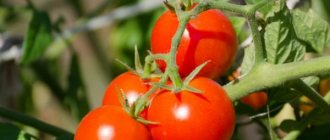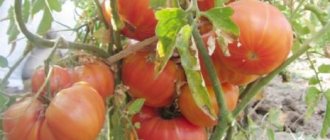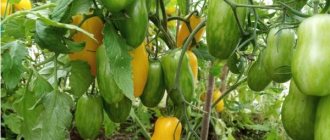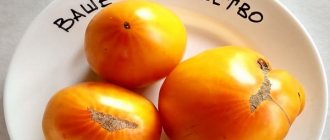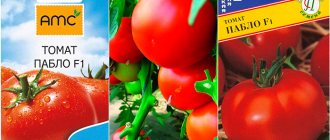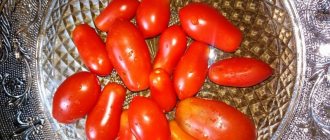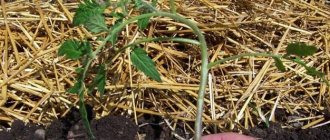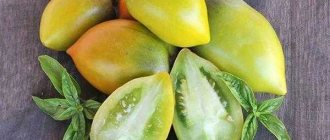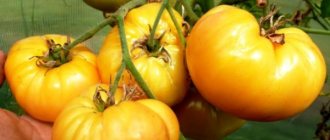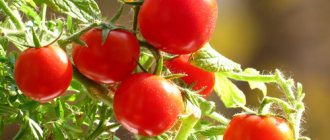The Siberian Shangi tomato is a spectacular variety with impressive large fruits, the taste of which is rich and deep. Their pulp is sugary, meaty and suitable for both processing and fresh salads.
| Height | Landing location | Ripening time | Fruit color | Fruit size | Origin | Fruit shape |
| Tall | Greenhouse | Mid-early | Pink | Large | Variety | Flat-round |
Characteristic
The fruits of the Siberian Shangi variety are pink. They are classified as tall and mid-early species. It does not like frosts; in the central part of Russia it is better to plant mainly in a greenhouse. In the southern regions, planting in open ground is permissible, but only when the average temperature reaches acceptable values. Tomato fruits contain virtually no seeds. The average fruit weighs from 300 grams, in most cases the weight can reach 700-800 grams. One such tomato is enough to cut into a salad. Tomatoes have elastic, hard but thin skin. It protects against cracks and damage.
This type of tomato has a thick, strong stem that can support the fruits until they ripen. The plant reaches a length of up to two meters during the fruiting period. There are 5-6 clusters of tomatoes on the trunk. To improve the quality of the crop, it is recommended to carry out pinching in a timely manner. All side shoots are removed and the tomatoes grow into one stem. There are few leaves on the trunk.
Tomato Siberian shangi
photo by Valentina Redko
Description and characteristics of the tomato variety Siberian Shangi, reviews, photos
Tall, mid-early, large-fruited variety of tomatoes from Siberian breeders. In the middle zone, it is recommended to grow it in a greenhouse.
The bush is powerful, up to 1.8 meters high. Requires tying to the support and pinning. The manufacturer recommends forming the plant into 1 stem, removing all side shoots (stepchildren).
Basic qualities of fruits
The fruits are flat-round, dense, pink-raspberry color at maturity, weighing 300-400 grams (up to 800 g), fleshy, good tomato taste. Not prone to cracking. These tomatoes are suitable for fresh consumption, making juices and sauces.
Features of growing tomato Siberian Shangi, planting and care
We recommend sowing the seeds of this tomato for seedlings 60-65 days before the intended planting in the ground. Seedlings dive at the stage of two true leaves. When planting seedlings in a permanent place per 1 sq. It is recommended to place up to 3 plants per meter of land.
Further care for tomatoes consists of timely watering, fertilizing with complex mineral fertilizer, pinching and preventive measures to protect against diseases and pests.
When growing tomatoes in a greenhouse, we recommend installing a drip irrigation system - this saves your time and effort, and also increases plant productivity and reduces the risk of late blight.
If you grew Siberian Shangi tomatoes, please write whether you liked them or not. What was the yield and taste of the fruits like under your climatic conditions? How do you rate the disease resistance of this variety? Briefly describe the advantages and disadvantages of this tomato in your opinion. If possible, attach a photo of your tomatoes to your comment. Thank you!
Your reviews of the Siberian Shangi tomato and additions to the description will help many gardeners evaluate this variety more objectively and decide whether it is worth planting or not.
Growing
Two months before the intended planting, you need to sow the seeds. Seeds can be purchased if the variety is planted for the first time. For the future, during the summer season, it is better to save the largest and ripest tomato, or maybe a couple, cut it, extract the seeds from it, and dry it. In spring, sowing is carried out from dried seeds. This improves the taste of the tomatoes; they will be even larger in size than their predecessors.
Before planting, seeds must be rendered harmless from pests and foreign substances. To do this, they are soaked in a weak solution of baking soda. The soil for planting seedlings must also undergo pre-treatment: it is either frozen for several days in the cold, or calcined for a couple of hours in the oven. It is believed that after this procedure the land is disinfected. In the prepared soil, shallow grooves about a centimeter wide are made at some distance from each other. The seeds are placed in the furrows and the soil is shed. To quickly hatch the sprouts, you need to cover them with windproof material. The temperature in the container with seedlings should be about 26 degrees.
As soon as the sprouts have sprouted, the seedlings are transferred to regular watering and spraying. Tomatoes love water, but they should not be overwatered, otherwise the roots may become diseased and rot. When the plant becomes cramped in a common container, it is necessary to carry out a second transplant into individual containers. This must be done very carefully to avoid injury to the plant. It is better to place the seedlings on the window, where they will have enough light.
Tomatoes are transplanted into the greenhouse in early May. Just in time for this period, the weather will normalize and the seedlings will get stronger.
Plant seedlings of no more than three bushes per square meter, as the bushes will grow large.
You need to remember to maintain the temperature; for this it is better to ventilate the greenhouse at least sometimes and give the plants fresh air. But it is better to do this before June no more than once every few days. Tomatoes love soil with peat and sand. This must be taken care of in advance, preferably in the fall. If that doesn’t work, you can add a little humus to the soil, thereby stabilizing the growth of tomatoes. It is important to remember that the plant takes all its nutrients and vitamins from the earth. The root system absorbs all the benefits of the soil, and the more of it there is, the better for the crop.
Tomato Siberian Shangi - description of the variety with photos
Mid-season Siberian Shangi tomatoes stand out among other varieties with the following positive qualities:
- unpretentiousness to growing conditions;
- good yield;
- storage duration;
- ability to ripen;
- good transportability;
- do not require special care;
- resistance to temperature changes;
- immunity to fungal diseases.
But besides the advantages, the Siberian Shangi variety has the following disadvantages:
- needs a garter, otherwise the plant will break under the weight of the fruit;
- not suitable for whole fruit canning.
Productivity
The Siberian Shangi tomato belongs to the category of large-fruited varieties. The growing season from the appearance of the first shoots to the beginning of fruit ripening does not exceed 100-110 days. If all planting conditions have been met, the first harvest can be harvested at the end of July. On average, the weight of one tomato is 500-600 grams. With proper and regular care of the plant, the weight of the fruit can increase to 800-900 grams.
Watering and fertilizing
After transplanting, tomatoes are watered often, but as the soil dries out. It is imperative to loosen the soil to ensure normal root development.
You may be interested in: Dates for planting tomato seedlings in open ground and greenhouses according to the garden calendar Favorable days for planting tomatoes for seedlings in 2021 according to the lunar sowing calendar Favorable days for picking tomatoes in 2021 after germination: timing of picking tomato seedlings in the table by day
You can use fertilizers and feed the soil. Most often, fertilizing is carried out with phosphates and their derivatives. They improve the appearance of the plant, the leaves become brighter in color, and the tomatoes themselves have a richer taste.
But you need to be careful with fertilizers and not harm the tomatoes. Breeding instructions must be carefully followed. And the use of fertilizers based on chicken manure or mullein has a strong effect, you can even burn the measles system. In general, the main thing is to know when to stop and not to overdo it.
Tomato Siberian Shangi - description and characteristics of the variety
Characteristics
It can be grown both in greenhouses and in open ground. However, in the central zone it is more often recommended to grow in greenhouses. In terms of ripening, it is considered medium early. Fruit ripening begins with feeding 120 days after seed germination. According to the habit of the bush (growth characteristics) - an indeterminate, dominant stem can reach a height of 2 meters.
Each plant naturally grows 5-6 clusters of fruit. The yield is up to 10 kg per square meter. m. A piece of fruit can reach 800 grams, occasionally up to 1 kg, on average - 300 g. Therefore, one fruit is usually enough to make a salad. The pulp is fleshy, not at all watery, with aromatic flavor. The taste is sweet with a pleasant aftertaste. The fruits are resistant to cracking.
Recommendations according to cultivation
It is recommended to sow seeds 2 months before planting on top in a permanent place. Before sowing, home-produced seeds are usually recommended to be disinfected by physical means, or by using chemical or biological agents. Soda, a weak solution of potassium permanganate, and some fungicides help with chemicals. It may also be advisable to use biological fungicides, for example Alirina-B.
When sowing, it is recommended to plug the seeds to a depth of 1.5-2 cm. After sowing, the container with the seeds must be covered with film or glass and placed in a warm place, potentially with a temperature of about 26 degrees. After the seeds germinate, the container with the seedlings will be kept at a temperature of about 17 degrees.
After the formation of two true leaves, you need to wound (cut) the seedlings into separate glasses. If plants grow slowly and their leaves are pale, it is advisable to feed them with a solution of nitrate or a complex fertilizer, such as Fertik. The effect can also be obtained from fertilizing with an extract of vermicompost. It is advisable to harden the seedlings a few days before planting. To please anyone, it is advised to place it in an open area for several hours, for example on a balcony.
Before planting seedlings, it is recommended to apply manure at a dose of 5-10 kg/sq. m. If there is little humus, then it is not prohibited to add humus - or vermicompost, or WMD - into the holes. Another option is to add humus with AVA fertilizer in a dose of 1/3 to 1/2 teaspoon in each hole. It is better to plant seedlings in this way, so that per square meter. m accounted for approximately 3 plants.
Care after landing
After the May glaciation ends (for the non-chernozem zone), the plants need to be tied to a trellis. Before the 3rd flower cluster blooms, you should try to make do only with potassium-phosphorus fertilizers, for example, ash, potassium monophosphate. At the onset of this phase, if necessary, you can fertilize with complex mineral (Zdraven, Rastvorin, etc.) or organic (Gumidar, Gumistar) fertilizers. The need for fertilizing depends on the initial level of soil fertility, the method of its maintenance, and pre-planting or pre-planting application of fertilizers. On relatively poor soils, for example, sandy soils in the non-chernozem zone, fertilizing with a solution of calcium nitrate and magnesium sulfate may be necessary. Calcium nitrate is needed for blossom end rot, and magnesium sulfate is needed for interveinal chlorosis of the lower leaves.
Generating plants comes down to removing the stepsons, as well as the leaves under the first flower cluster.
Plant protection
Tomato plants, including Siberian shangi, may suffer (suffer) losses from sunburn, diseases, and pests. To prevent sunburn, it is appropriate to harden the plants and spray them with a solution of Ecoberin in the evening. Diseases for tomatoes are infectious and physiological. The former can be divided into fungal, bacterial and viral. Fungal diseases include late blight, cladosporiosis, and macrosporiosis. The bacterial ones include infectious blossom end rot and black spot, and the viral ones include mosaics. The biological product Gamair is suitable for protection against bacterial spotting. It is worth exploiting it to prevent the top of rot. For the same purpose, it is permissible to deplete the antibiotic Fitolavin.
